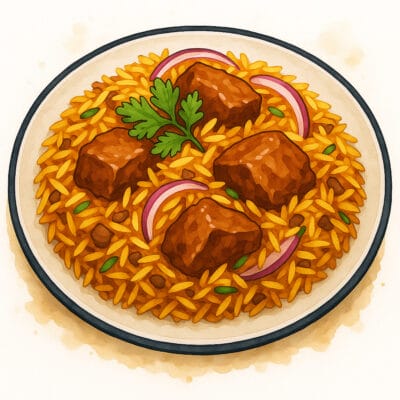Biryani Indiano Tradicional
O biryani é um prato indiano de renome mundial que representa o ápice da culinária do subcontinente, com origens que remontam à Pérsia como um prato rústico de arroz com carne que viajou para a Índia e evoluiu em inúmeras variações regionais. Este prato de ocasião especial requer tempo e prática para dominar, apresentando arroz basmati de grão longo em camadas com carne marinada, especiarias perfumadas como açafrão e molho grosso, tudo cozido junto usando o método tradicional *dum*.
Biryani Indiano

O Biryani é um prato indiano de renome mundial, com camadas de arroz basmati, carne marinada e especiarias aromáticas, cozido no método tradicional *dum*.
Ingredients
- 400 g (2 chávenas) de arroz basmati
- 1 kg de carne de cordeiro ou cabra, cortada em pedaços
- 240 ml (1 chávena) de iogurte natural
- 2 cebolas grandes, fatiadas finamente
- 60 ml (1/4 chávena) de ghee (manteiga clarificada)
- 1 colher de chá de pasta de gengibre e alho
- 1 colher de chá de pó de pimenta vermelha
- 1/2 colher de chá de açafrão
- 60 ml (1/4 chávena) de leite morno
- 4-5 vagens de cardamomo verde
- 2 paus de canela
- 4-5 cravos
- 2 folhas de louro
- Sal a gosto
- Folhas de hortelã frescas
- Folhas de coentro fresco
- Cebolas fritas para decorar
Directions
- Marine a carne com iogurte, pasta de gengibre e alho, pó de pimenta vermelha e sal por pelo menos 1 hora.
- Demolhe o açafrão no leite morno e reserve.
- Frite as cebolas fatiadas em óleo até ficarem douradas e crocantes. Reserve.
- Cozinhe o arroz basmati com as especiarias inteiras até ficar 70% cozido. Escorra e reserve.
- Numa panela de fundo grosso, cozinhe a carne marinada em ghee até ficar macia.
- Faça camadas: espalhe metade do arroz, depois a carne, hortelã, coentro e cebolas fritas.
- Cubra com o restante arroz e regue com o leite de açafrão e mais um pouco de ghee.
- Cubra hermeticamente com papel de alumínio e a tampa, e cozinhe em lume baixo por 45 minutos.
- Deixe repousar por 10 minutos antes de servir.
- Decore com cebolas fritas, hortelã e coentro frescos.
Nutrition
Por porção (aprox. 300g): 650 calorias; 25 g de gordura; 75 g de carboidratos; 35 g de proteína; 70 mg de colesterol; 800 mg de sódio.
Traditional Indian Biryani
Biryani is a world-renowned Indian dish that represents the pinnacle of subcontinental cuisine, with origins tracing back to Persia as a rustic rice-and-meat dish that traveled to India and evolved into numerous regional variations. This special occasion dish requires time and practice to master, featuring long-grained basmati rice layered with marinated meat, fragrant spices like saffron, and thick gravy, all cooked together using the traditional *dum* method.
Indian Biryani

Biryani is a world-renowned Indian dish, with layers of basmati rice, marinated meat, and aromatic spices, cooked using the traditional *dum* method.
Ingredients
- 400 g (2 cups) basmati rice
- 1 kg (2.2 lbs) lamb or goat meat, cut into pieces
- 240 ml (1 cup) plain yogurt
- 2 large onions, thinly sliced
- 60 ml (1/4 cup) ghee (clarified butter)
- 1 tsp ginger-garlic paste
- 1 tsp red chili powder
- 1/2 tsp saffron
- 60 ml (1/4 cup) warm milk
- 4-5 green cardamom pods
- 2 cinnamon sticks
- 4-5 cloves
- 2 bay leaves
- Salt to taste
- Fresh mint leaves
- Fresh cilantro leaves
- Fried onions for garnish
Directions
- Marinate the meat with yogurt, ginger-garlic paste, red chili powder, and salt for at least 1 hour.
- Soak the saffron in warm milk and set aside.
- Fry the sliced onions in oil until golden brown and crispy. Set aside.
- Cook the basmati rice with the whole spices until it’s about 70% done. Drain and set aside.
- In a heavy-bottomed pot, cook the marinated meat in ghee until tender.
- Create layers: spread half the rice, then the meat, mint, cilantro, and fried onions.
- Top with the remaining rice and drizzle with the saffron milk and some more ghee.
- Cover tightly with foil and a lid, and cook on low heat for 45 minutes.
- Let it rest for 10 minutes before serving.
- Garnish with fried onions, fresh mint, and cilantro.
Nutrition
Per Serving (approx. 300g): 650 calories; 25 g fat; 75 g carbohydrates; 35 g protein; 70 mg cholesterol; 800 mg sodium.